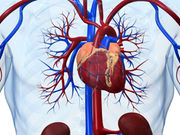Predictors of noncardiac death include older age, inducible ischemia, higher heart rate, statin nonuse
MONDAY, Dec. 19, 2016 (HealthDay News) — For patients with coronary heart disease (CHD), mortality is more often due to noncardiovascular causes, according to a study published in the Jan. 1 issue of The American Journal of Cardiology.
Elizabeth Y. Wang, from the University of California in San Francisco, and colleagues determined the proportion of patients with CHD who died from cardiovascular versus noncardiovascular causes and the causes and predictors of death. A total of 1,024 participants from the Heart and Soul Study with stable CHD were enrolled from 2000 to 2002 and followed for 10 years.
The researchers found that 401 participants died during 7,680 person-years of follow-up. Of these deaths, 42.4 and 54.4 percent, respectively, were cardiovascular and noncardiovascular. Seventy-two percent of cardiovascular deaths were accounted for by myocardial infarction, stroke, and sudden death. Sixty-seven percent of noncardiovascular deaths were accounted for by cancer, pneumonia, and sepsis. Older age, inducible ischemia on stress echocardiography, higher heart rate at rest, smoking, lower hemoglobin, and higher N-terminal pro-brain natriuretic peptide were independent predictors of cardiac mortality (all P < 0.05). Older age, inducible ischemia, higher heart rate, lower exercise capacity, and nonuse of statins were independent predictors of noncardiac mortality (all P < 0.05).
“In conclusion, mortality in this cohort was more frequently due to noncardiovascular causes, and predictors of noncardiovascular mortality included factors traditionally associated with cardiovascular mortality,” the authors write.
Full Text (subscription or payment may be required)
Copyright © 2016 HealthDay. All rights reserved.








